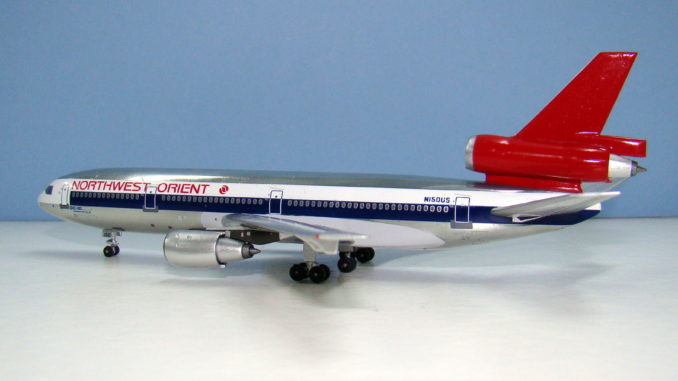
Aeroclassics have made lots of DC-10s but until October 2016 they had not crafted a series 40 version. Since then they have been dribbling out almost all the viable DC-10-40s but had been keeping their powder dry as regards Northwest examples. That all changed in July with the release of 3 versions of the classic thermometer liveried DC-10. After such a long wait is it a worthy addition to your collection?
THE REAL THING
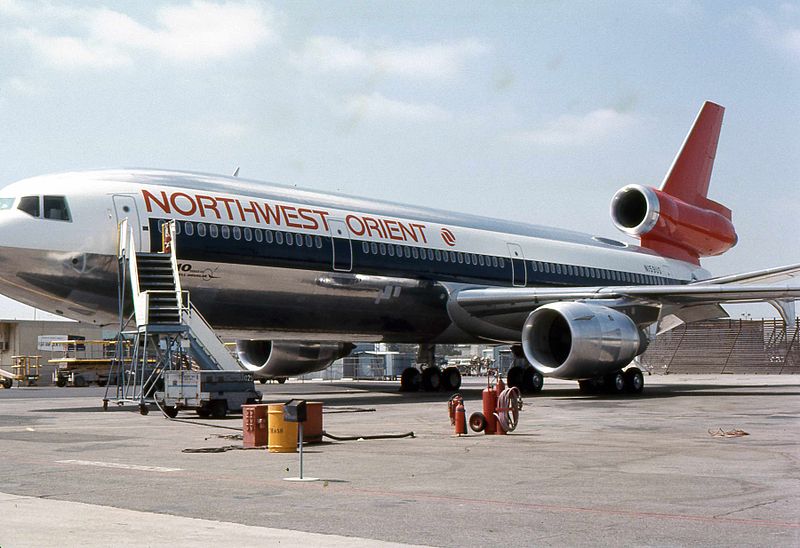
Aside from Pan American and TWA Northwest Orient was the only other US trunk airline with enough of an international network to justify large numbers of long range widebodies. Braniff had an extensive Latin American network, but it was well served by DC-8-62s especially in the hot and high conditions encountered at several of its South American stops. Orient had been a long time Douglas customer until the 1960s, having operated DC-3s, DC-4s, DC-6s, DC-7Cs and DC-8s. Its experience with the Eights wasn’t satisfactory and Douglas lost out to Boeing throughout the 1960s as Northwest acquired substantial fleets of 707s, 720s and 727s.
Northwest bought both the 747 and the DC-10 but they weren’t interested in the General Electric powered DC-10-30 long-range variant that would eventually form the majority of orders. Their CEO Donald Nyrop famously said at the time:
“If I want a light bulb, I’ll go to GE; if I want an engine, I’ll go to Pratt & Whitney.”
So to keep Northwest, and Japan Air Lines, happy McDonnell Douglas designed and built a new variant to be called the DC-10-20. This was to be equipped with the JT9D-15 turbofan but otherwise matched the GE powered DC-10-30. In the end the engines were JT9D-20s and the variant name was changed at Northwest’s request to the DC-10-40 so it would seem like a newer variant than the series 30, and Northwest could boast about it. McDonnell Douglas certainly went the extra mile to keep the customer happy!
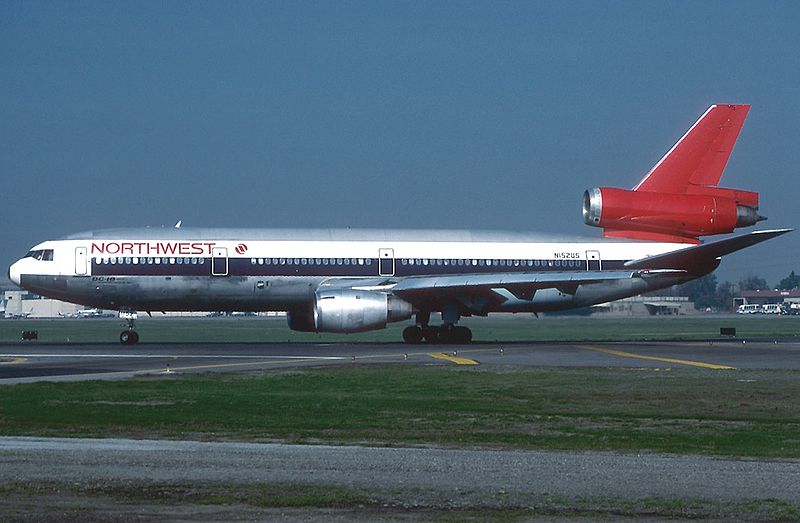
Northwest Orient began DC-10 operations in late 1972 with the first of 22 series 40s (20 more were built for JAL). The main external difference between the DC-10-30 and 40 is the engines and shape of the centre engine intake. The series 40 has a slight bulge at the front of the middle #2 engine intake. The majority of Northwest’s series 40s remained in service into the new millennium and perversely the DC-10 fleet actually peaked in number in 2001 as Northwest had acquired 24 DC-10-30s and still operated 21 of its series 40s. The last DC-10-40s were retired in late 2002 but the DC-10-30s soldiered on until January 2007. This aircraft, N150US, was delivered on July 31, 1973 and served until retirement on September 5, 2001.
THE MODEL
The format for my reviews is to split them into three key areas:
- The mould of the aircraft
- The paint and livery
- Printing and quality control
Each can get a maximum score of 10 for a section giving a maximum combined total score of 30.
THE MOULD
The Aeroclassics DC-10 mould is one of their finest mouldings and arguably the best DC-10 ever produced in 1/400 scale. Only Dragon Wings / Jet-X had attempted an accurate DC-10-40 until this new Aeroclassics mould was made. Now in general most people are quite happy with the Dragon DC-10 (I own several myself including series 40s) but realistically it can’t compete with the AC DC-10.
The Aeroclassics DC-10 is better in almost every respect but especially the nose and undercarriage of the Aeroclassics DC-10 are very good. A nice touch on Aeroclassics DC-10s is that the nosegear comes separated in a little bag so as to avoid breakages during posting. There are no faults with the fuselage, wings and engines of the mould that are worth mentioning.
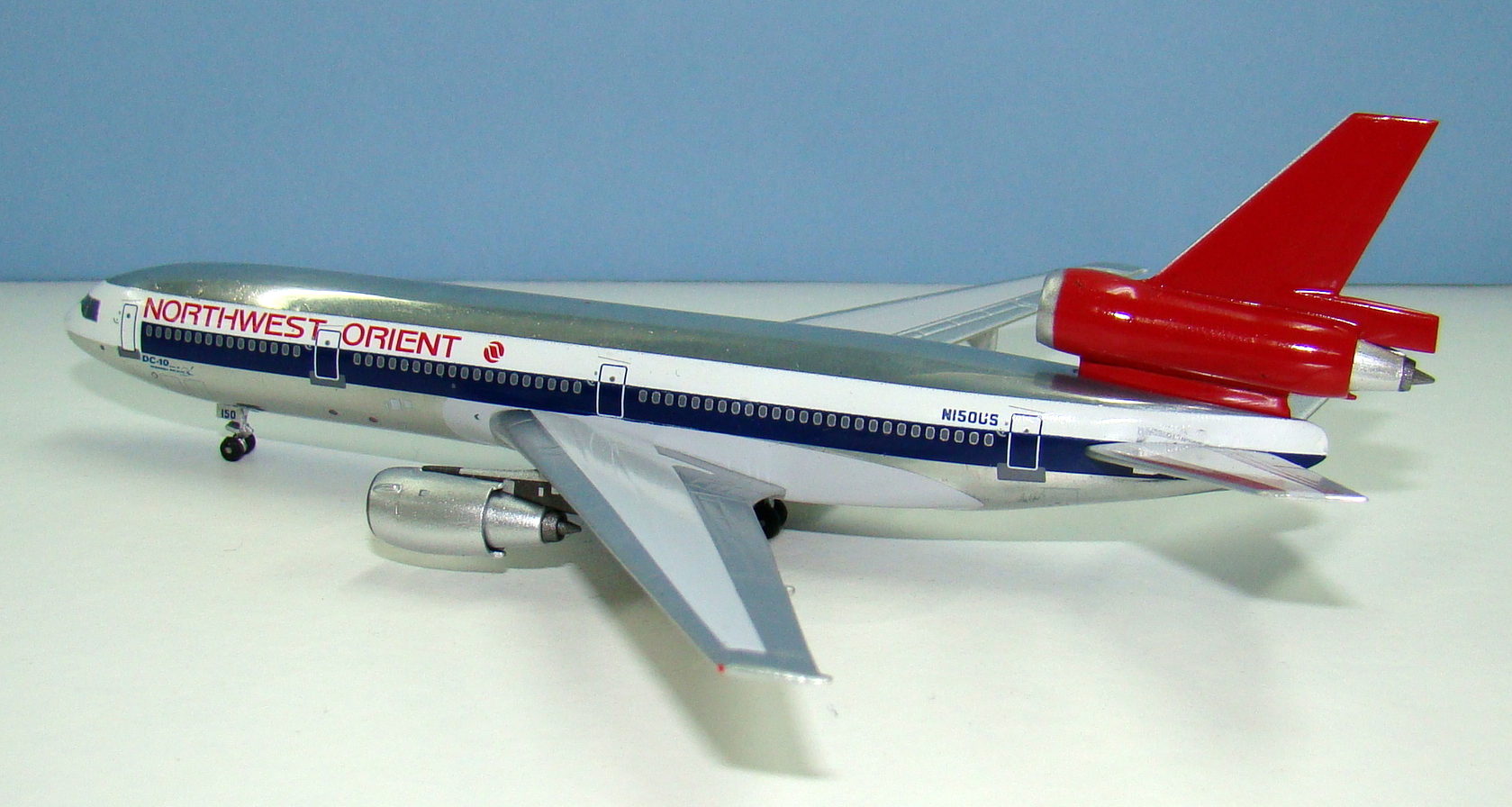
Moving to the all important vertical stabilizer and the characteristic shape of the central engine is present, with a well defined bulge at the intake. If the Aeroclassics DC-10 does have a failing it is the tubelike shape of the tail mounted engine, which isn’t as curvy as it ought to be. It isn’t really very noticeable especially when it’s all a single dark colour as it is here. Moving to the exhaust for the no 2 engine and it is clear Aeroclassics have not made as much effort to get it correct as they ought to have.
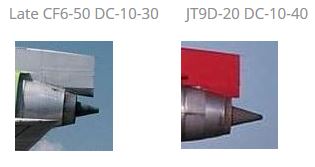
Most 1/400 DC-10 moulds have a couple of exhaust variants to enable them to pretend to be either DC-10-10s or DC-10-30s however there were actually 6 different DC-10 exhaust configurations, which means that the manufacturers generally try to create generic exhausts that can pass as any of a few variants. Here although Aeroclassics have worked on the front of the engine the exhaust looks little like a DC-10-40 with JT9D-20s. The actual exhaust is fine but the fin attachment above it is too long and attaches at the wrong place. It’s not a deal breaker but it most closely resembles a late model DC-10-30.
For more information see my comprehensive DC-10 mould review.
Overall this is a great mould, but I’m knocking off 2 points for issues with the no 2 engine.
SCORE – 8
PAINT & LIVERY
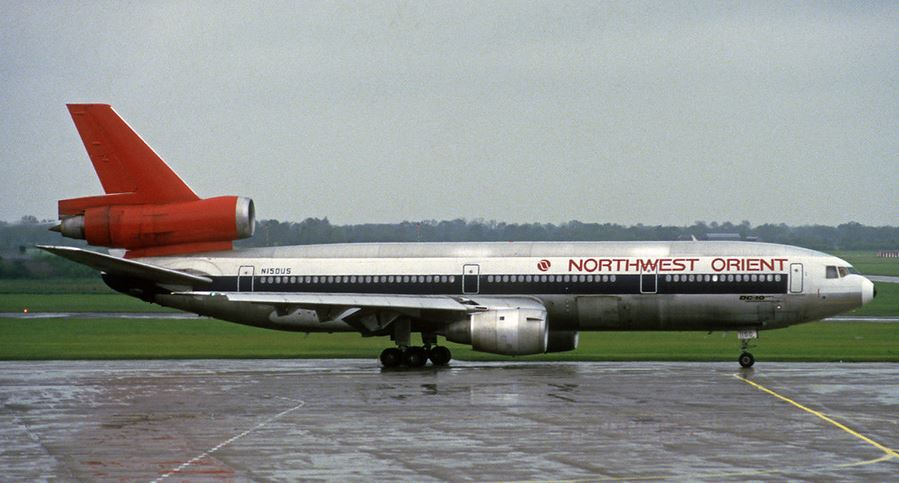
Northwest had the easily recognizable all red tail for over 60 years but it has to be said that the 1969 introduced ‘thermometer’ livery was not the most attractive version of their livery. Nonetheless it did have a rather rugged and powerful look to it with the natural metal roof and belly with white centre section and very dark blue cheatline.
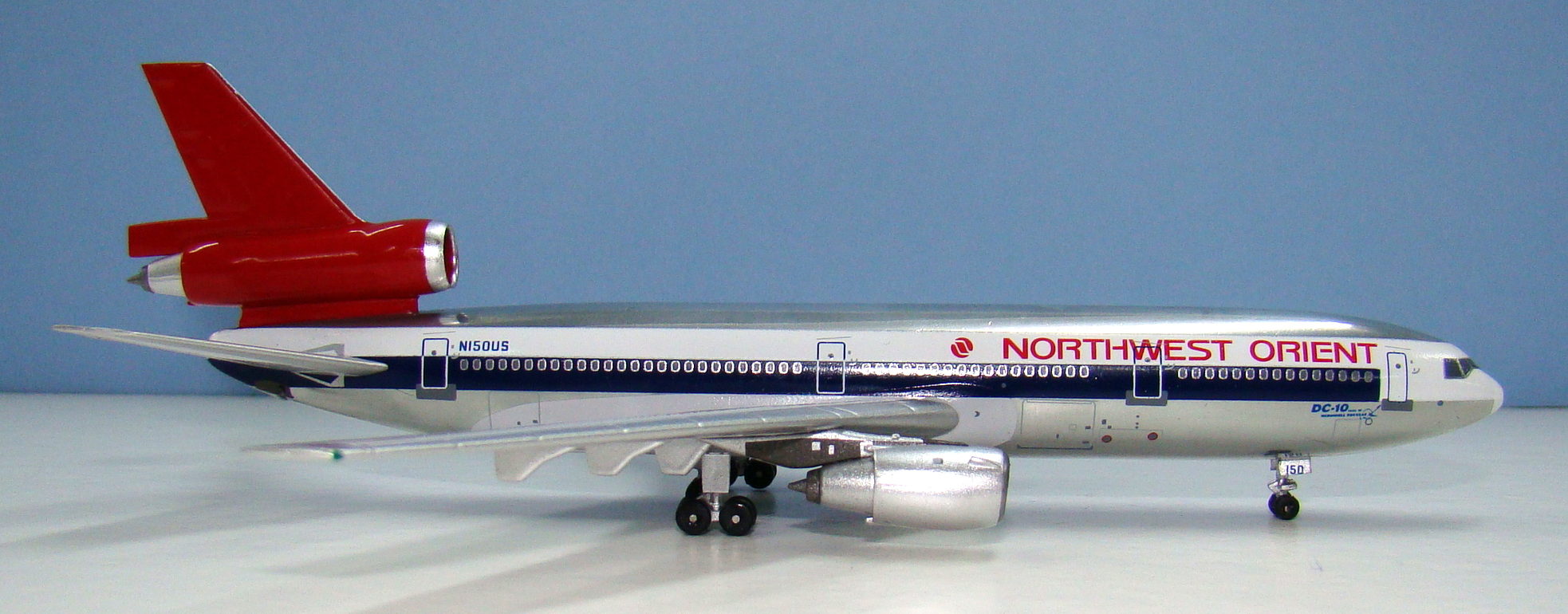
Aeroclassics have a regular colour shade issue on their models, but at least they are consistent. I have loads of Northwest ‘thermometer’ Aeroclassics models and they all have the same shade of dark red, unfortunately it is the wrong shade of dark red. The tails shouldn’t really be dark red at all but instead a more medium red. Even in bad light the tails on the real thing look a lot brighter than the Aeroclassics version. I knew this before I bought the model and it does match with the rest of my fleet so it isn’t a major issue for me, but it is something to be aware of.
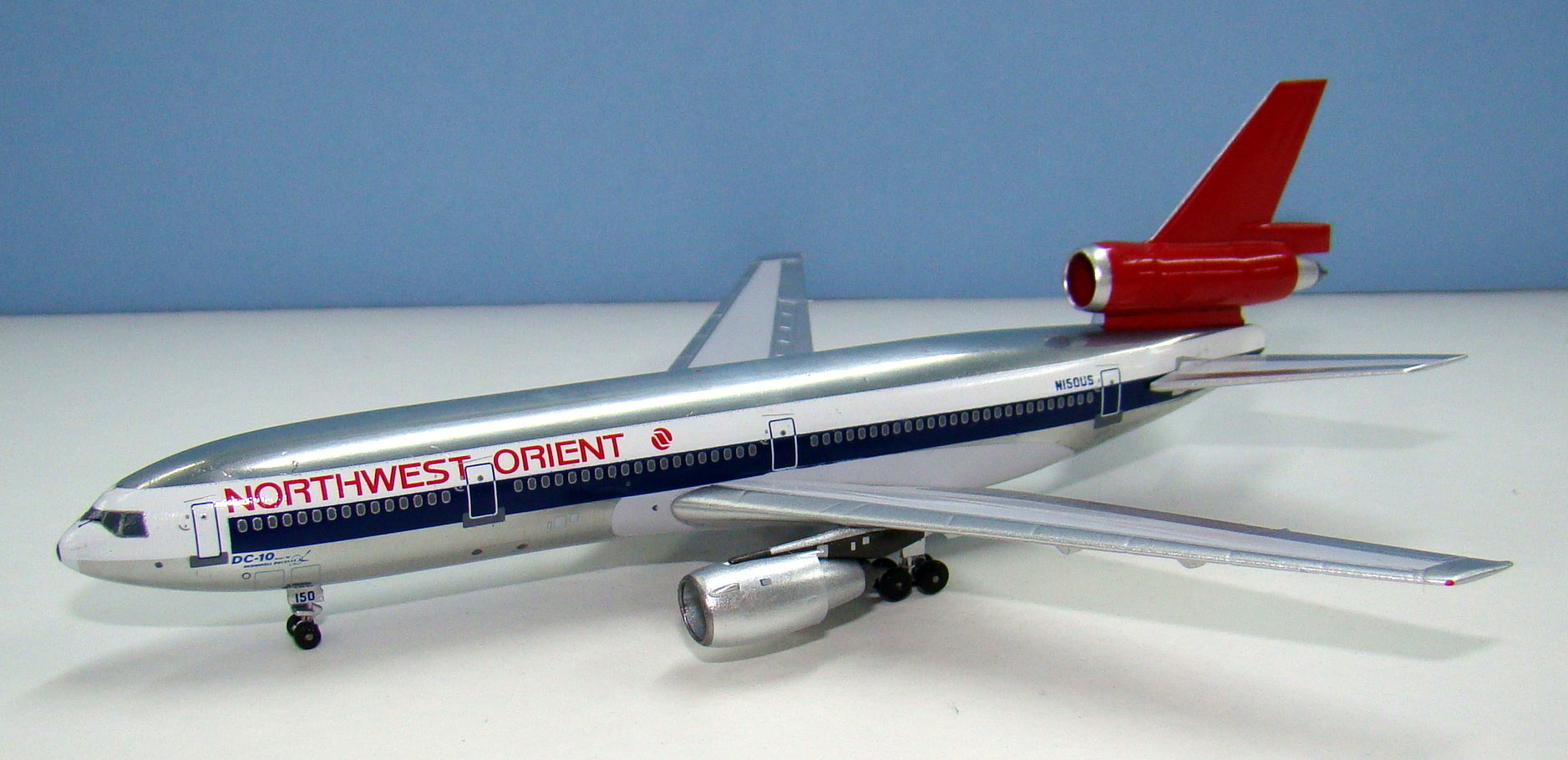
Placement of other livery elements and the font of the titles (for once!) are all accurate, although I have to add that the sister release to this of N143US with extra DC-10 titles has incredibly inaccurate titling of the extra DC-10 bit. The size of the black radome is perhaps a little too small but it is minor.
SCORE – 8
PRINTING & QUALITY CONTROL
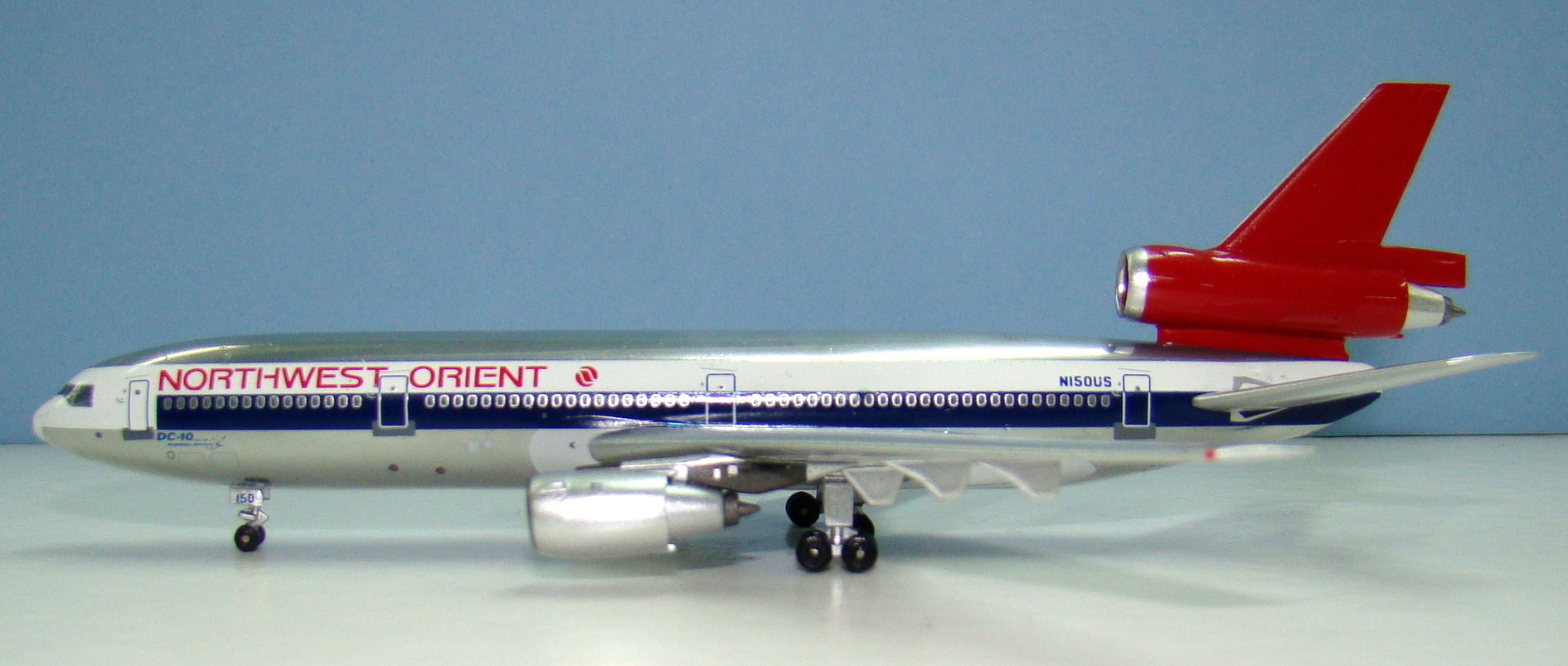
Printing on the model is excellent. It is very detailed and of a high spec. Highlights include the small McDonnell Douglas title and logo by the forward passenger doors and some light grey paneling ahead of the wing. The tail is lacking some detail – probably due to the darkness of the paint and the thickness of its application, as are the underwing engines. The wings are particularly nicely detailed and crafted. The fanblades on the engines are disappointingly very silver.
Construction of the model is tiptop with no problems whatsoever.
SCORE – 9
CONCLUSION
This is a fine model, however Aeroclassics seem unwilling or unable to fix fundamental issues like the darkness of their colours. Perhaps given all the Northwest releases it is simply too late to change to a more accurate shade of red? The new DC-10-40 is a success where it matters most, but if you are going to make a new tail moulding why not make it correct? Even so these issues don’t affect my overall enjoyment of the model and it fits well into my large Northwest fleet.
FINAL SCORE – 25


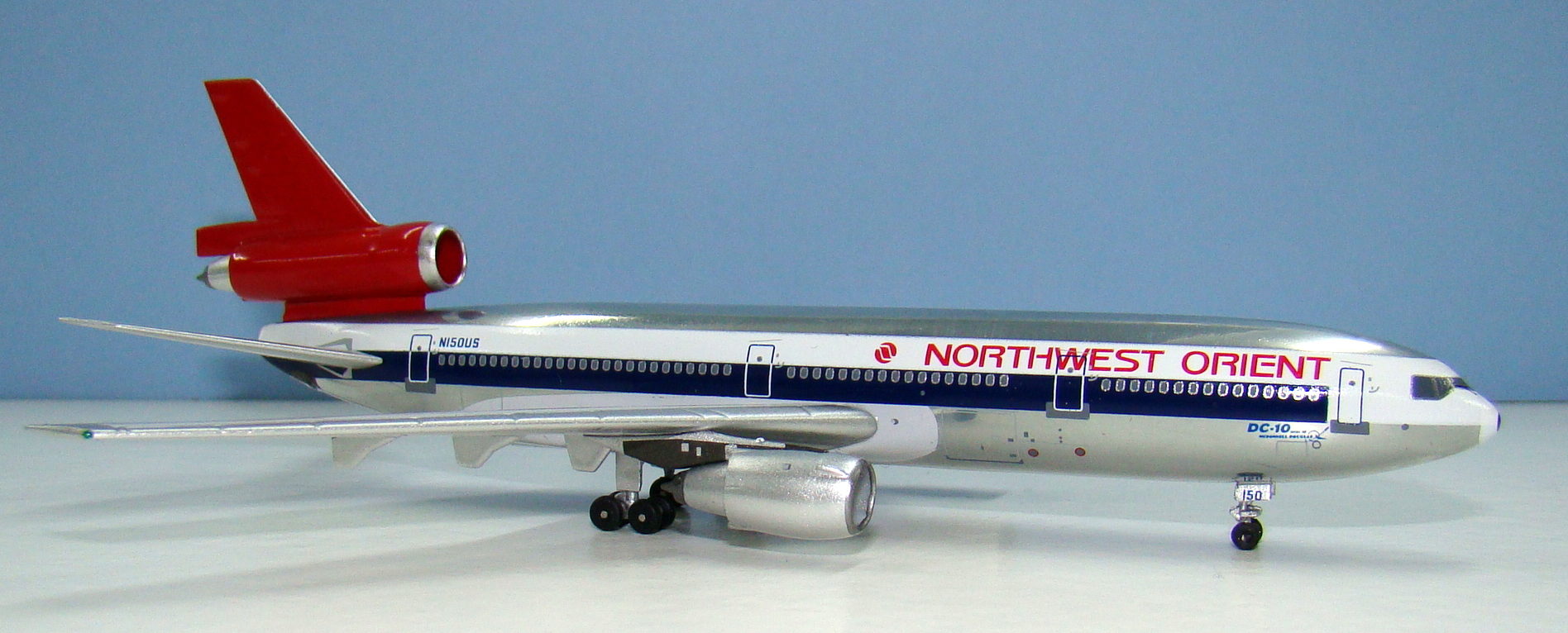
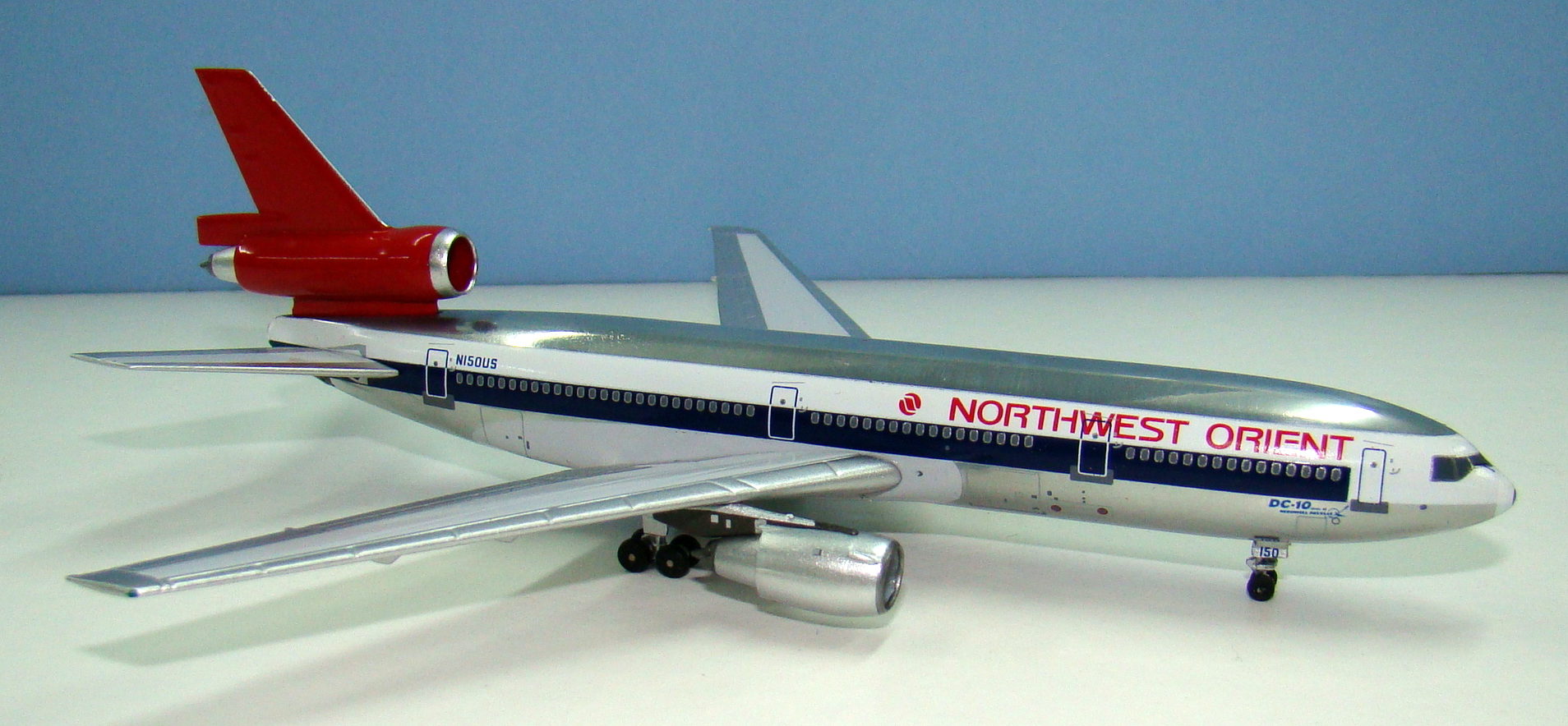
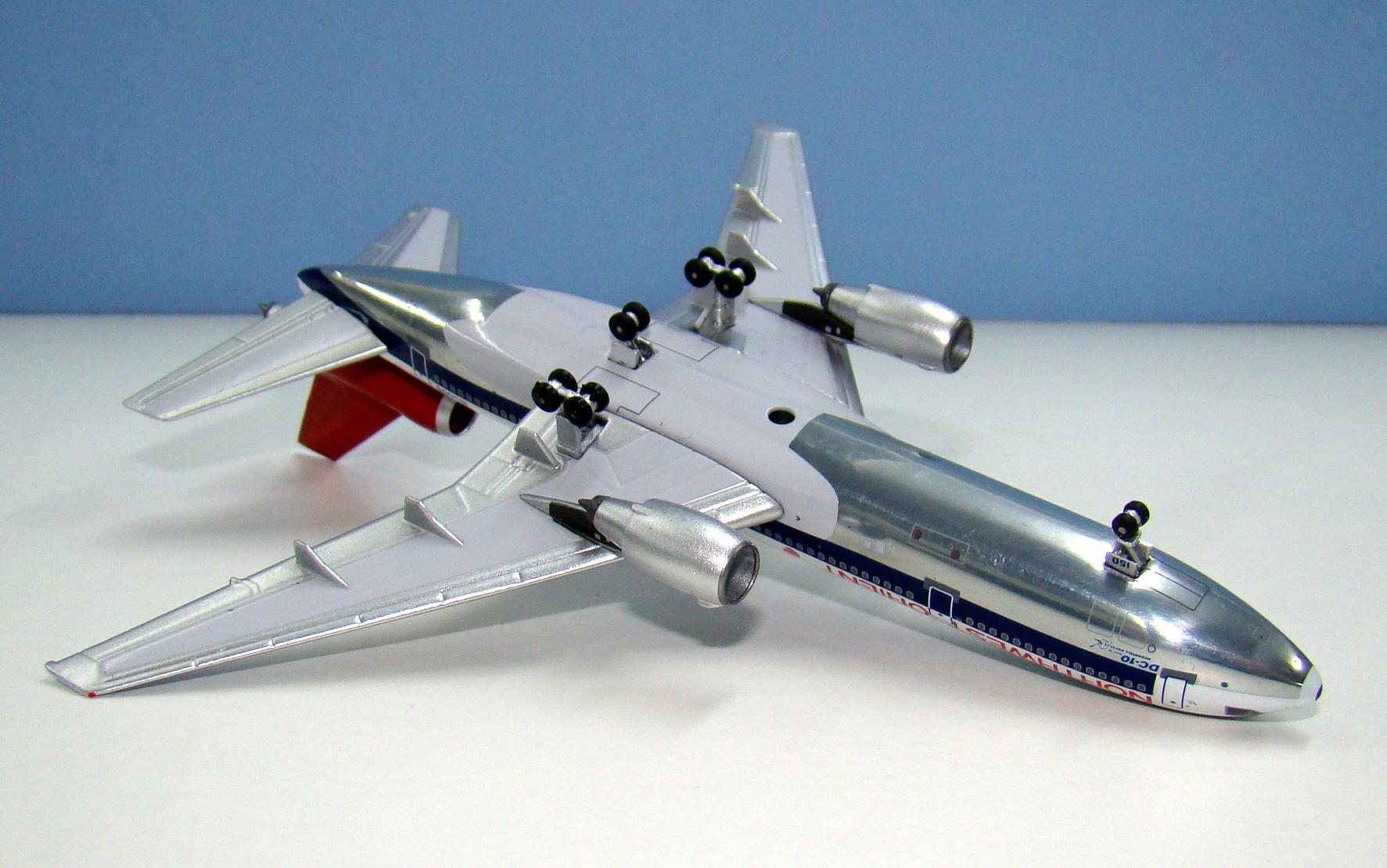

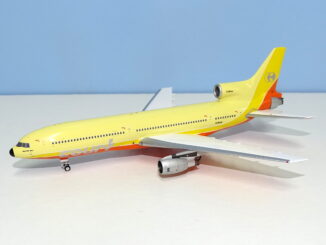
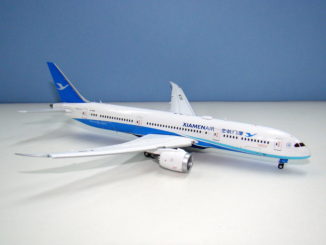
Great review Richard, but I thought you might encompass all three Northwest livery variations released at the same time? This ‘dark shade’ of red has been mentioned several times before on other Aeroclassics Northwest models, but clearly falls on deaf ears. I am very happy with my two Dragon Wings Northwest/Northwest Orient DC-10s that have the correct shade of red on their tails, so will pass on the AC versions.
The 1969 Thermometer livery is in my view a beautiful Northwest Orient livery. Simple, elegant, and bold. The livery compared well with other colorful USA trunk- and local-service-carrier liveries of the 1970’s, and the red tail always stood out brightly on an apron.
IF I remember right, Northwest dropped ‘Orient’ at the 1987 integration of Republic Airlines, to reflect its broader network. As indicated in your picture above, the airline initially kept the Thermometer livery without the word ‘Orient.’ In my view, they would have done better to have stuck with this timeless classic scheme of aviation history, rather than introducing the very period-specific Landor bowling-shoe scheme. Unfortunately, the airline’s well-known customer-service difficulties during the integration of Republic (for instance, at DTW, whose Smith / Davey terminal complex was not built to be a hub) likely killed any possibility of keeping the Thermometer.
This is a model for which I have waited all my years of Aeroclassics collecting. I share your 25 assessment. The “Northwest” DC-10-40 is also excellent and is a great addition to my 90’s section (the Bowling Shoe was introduced in 1989, but wasn’t painted on all aircraft immediately). The atrociously wrong “DC-10” titles on the delivery-era DC-10-40 have moved me to demote that model, which I confess to having panic-bought after the aggravating AeroPeru red-top DC-8 situation, to the for-sale category. It’ll go on eBay.
Kudos to Aeroclassics for having made a DC-10-40 and beginning to close that sore-thumb gap in their DC-10 lineup. I eagerly await a Japan Air Lines DC-10-40 in delivery-cheatline livery.
Jim
Another great review, Richard. I just got a copy of N154US (“NORTHWEST” titles). I hadn’t noticed until I reread your review that mentioned “some light grey paneling ahead of the wing”, but Northwest’s -40’s did not have these wing root fairings. MDC didn’t start modifying the DC-10 until October, 1974 to reduce fuel burn rates (ref Terry Waddington’s “McDonnell Douglas DC-10” pg 89 re: “Drag Improvements”). NWA had received all their -40’s prior to the introduction of these drag reduction improvements, the last one, 1162, being received by 06DEC1974. Compare the photos in your review to the actual model; you’ll see the difference. Overall, a very nice model, but I’d deduct another point for this error.